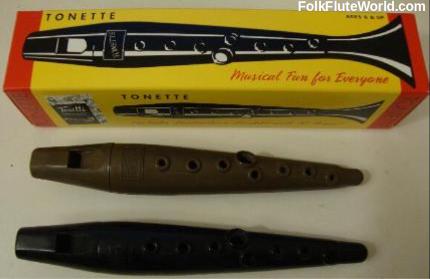by Howard Fosdick © FolkFluteWorld.com.
A tonette? What's that?
A tonette is a lightweight plastic flute about 7 to 9 inches long that has a closed end. It is a type of flute called an ocarina, because it has a closed end, rather than the open end you see in concert flutes. The closed end gives the tonette a unique sound.
Here's how they look:

Tonettes come in a variety of colors and plastics. All have closed ends. Some have a flared bell on the end, but if you peer inside the bell you'll see that the end is closed. The bell is just for show.
If the instrument doesn't have a closed end, it's not a tonette. (It may be a Song Flute, a similar looking instrument that is actually an open-ended plastic flute. People often confuse the two.)
Background
The tonette was invented in the late 1930s. The instrument became widely popular for introducing American schoolchildren to music in the 1940s through the 1980s. No one knows how many tonettes were made, but they undoubtedly number in the millions. As far as I've been able to determine, they haven't been produced since the 1990s.
Tonettes finger like most ocarinas and other simple flutes. Their range is from C5 through D6. You can extend this on the upper end by hollowing out the molded finger coverings for your left smallest figure and right thumb. This gives you a range of two more notes, from C5 to F6. This modification is easy to perform with a small penknife. You can see that the brown tonette in the picture above was modified like this.
Tonettes can play all sharps and flats in their range. You have to half-hole to get low C#.
Sound Quality
Tonettes were made over several decades by different companies. Sound quality varies -- a lot. Some sound like high quality ocarinas. Others toot like cheap plastic kids' toys.
Here are sound samples for some of the good ones. This tonette beautifully sings "Amazing Grace". (Note that the musician has labeled his video "Song Flute" but it's very clear he's actually playing a tonette.)
Here's a rendition of "Scarborough Fair".
As with all ocarinas, the highest notes sound a bit airy because you have all finger holes open. You must blow harder to hit them in tune. The "acute bend" technique some ocarinists use to hit high notes is not necessary.
Intonation varies by the manufacturer. Most tonettes hit whole notes accurately while pitch on the accidentals varies by the maker. A good quality tonette will play the entire chromatic scale in tune.
Tonettes are typically two-piece instruments that you can tune by moving the mouthpiece in or out. This tunability can be a big advantage over non-tunable ocarinas when you play in a group situation. Taking the mouthpiece off also allows you to clean the inside of the instrument and dry out any moisture that has accumulated.
Summary
I like tonettes because they give me another kind of ocarina with its own unique sound. It's fun to have a varied set of ocarinas to play and tonettes are an essential part of my collection.
If you want to buy a tonette, you'll have to buy one second-hand because they're no longer manufactured. Check on eBay or similar website.
Unfortunately, it's really tough to know how good a tonette will sound without trying out that particular instrument. I've generally found that the older models sound better because they were made from a denser, heavier plastic. You can often spot them because they have a smooth, shiny sheen, instead of a flat black or matte finish.
Want to learn more? Check out my Ultimate Guide to the Tonette.
For comparison to other inexpensive folk flutes, this article compares Tonettes to Song Flutes, Flutophones, and the Suzuki Precorder.
Tonette Quick Facts
Style: Straight or "inline" ocarinaMaker: Several over the years including Swanson, Gibson, and Binary Arts
To Buy: They're no longer made, so you'll have to buy used. eBay prices typically range from $10 to $25 USD.
Pitch: Alto C
Range: C5 to D6. C5 to F6 with simple modification
Material: Plastic
Dimensions: length between 7.5 and 9 inches, width about 1" at the widest point
Weight: lightweight hollow plastic